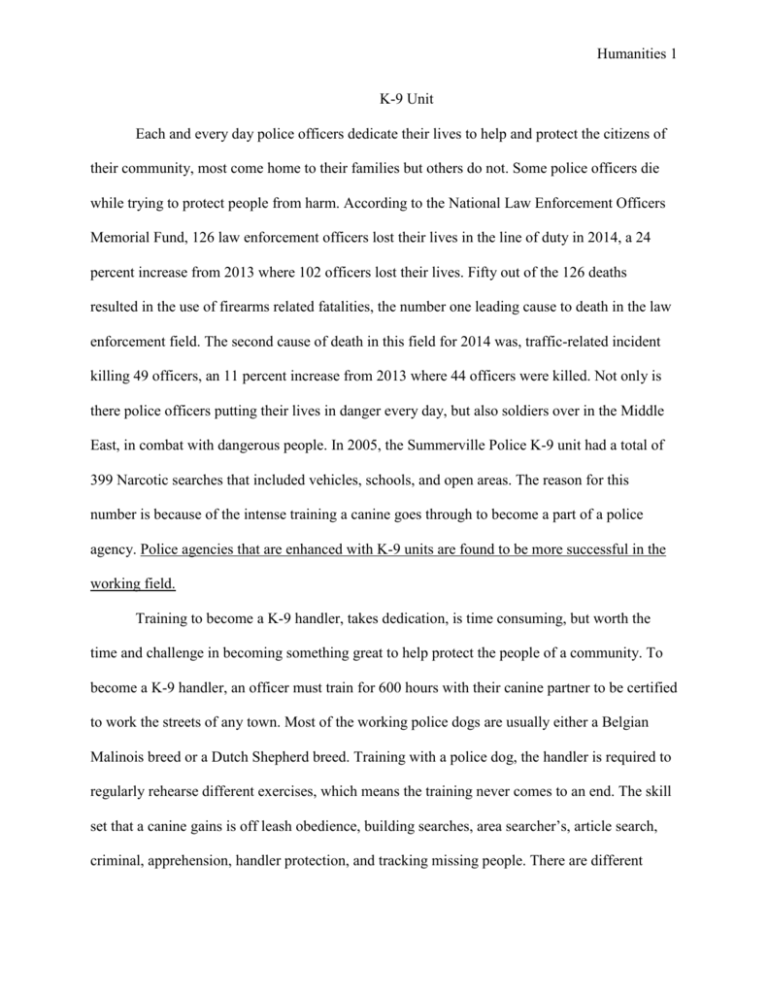File - Law enforcement: k
advertisement

Humanities 1 K-9 Unit Each and every day police officers dedicate their lives to help and protect the citizens of their community, most come home to their families but others do not. Some police officers die while trying to protect people from harm. According to the National Law Enforcement Officers Memorial Fund, 126 law enforcement officers lost their lives in the line of duty in 2014, a 24 percent increase from 2013 where 102 officers lost their lives. Fifty out of the 126 deaths resulted in the use of firearms related fatalities, the number one leading cause to death in the law enforcement field. The second cause of death in this field for 2014 was, traffic-related incident killing 49 officers, an 11 percent increase from 2013 where 44 officers were killed. Not only is there police officers putting their lives in danger every day, but also soldiers over in the Middle East, in combat with dangerous people. In 2005, the Summerville Police K-9 unit had a total of 399 Narcotic searches that included vehicles, schools, and open areas. The reason for this number is because of the intense training a canine goes through to become a part of a police agency. Police agencies that are enhanced with K-9 units are found to be more successful in the working field. Training to become a K-9 handler, takes dedication, is time consuming, but worth the time and challenge in becoming something great to help protect the people of a community. To become a K-9 handler, an officer must train for 600 hours with their canine partner to be certified to work the streets of any town. Most of the working police dogs are usually either a Belgian Malinois breed or a Dutch Shepherd breed. Training with a police dog, the handler is required to regularly rehearse different exercises, which means the training never comes to an end. The skill set that a canine gains is off leash obedience, building searches, area searcher’s, article search, criminal, apprehension, handler protection, and tracking missing people. There are different Humanities 2 extensive training sections to specifically become a Search and Rescue dog or a Drug Sniffing dog. To learn and understand the skill set, the canine goes through extensive training in different locations with different scenarios that may come up while in the field. Police dogs are trained in handler protection, which means they are trained attacking with or without command if their handler is being attacked or is being threatened in any way. In training, all dogs are trained with the use of body suits, hidden sleeves, and a muzzle. When the dogs are training to taken down the “suspect” in the body suit, the person in the body suit at the time, has to also attack the dog so the dog will learn how a person will react and to know not to let go until given the command from its handler. A study done by Officer Marie Wolfe of the Lansing Police Department K-9 Unit, a K-9 handler for three years, looked at a study. Officer Wolfe studied, “Does the utilization of police K-9 units enhance the Department’s efficiency and effectiveness through the reduction of time needed to perform certain tasks?”(Wolfe). The way this task was done was through search scenarios set-up’s in several different building sizes, and Officer Wolfe would have “suspects” hiding inside the buildings for the K-9 units to search for them and for officer units. While searching the buildings, Officer Wolfe “elapsed time and accuracy of the results were measured for comparison.” (Wolfe). The results to this study were that, “The police K-9 units outperformed the officer units both in terms of time required to search buildings and in accuracy of locating the suspects.”(Wolfe). The K-9 units surpassed the officer units with time and accuracy of searching in buildings for suspects. The importance of this study was “to be able to see if a canine team would actually result in savings in terms of time and personnel as resources available to police agencies…” (Wolfe). Doing this study, Officer Wolfe wanted to make others realize that having the use of a K-9 unit can be a greater degree of accuracy in finding suspects, Humanities 3 and could result in a reduction of the public's fear of crime in their town knowing that the police agencies have more support within them that has a higher percentage of being successful. Not only do police agencies have patrol dogs but have access to extensively trained Search and Rescue dogs (SAR). According to Julia Layton, as humans, we emit microscopic particles, alive or dead, and within the particles, is our scent, which is what helps a canine track and locate people. When humans emit microscopic particles, there are millions of these particles that are airborne and get carried by the wind for a substantial distance. The dog is trained to locate the scent of any human in a specific search area they are given; but the dog is not restricted the missing person`s track and can search long after the scent is obliterated. To add to the dog's training, not only do they train to track a scent in the air, they also are trained in trailing/scent discrimination. There are different specialties for SAR dogs; not all dogs perform the same type of search. Some dogs are tracking or trailing dogs where they work with their noses to the ground. The tracking dogs follow a trial of human scent through any type of terrain. These types of dogs are considered to not be searching dogs but following dogs because tracking dogs need a “last seen” starting point, only with an article with the missing person’s scent on it, and lastly an uncontaminated trial. Then there are the air-scent dogs who work with their noses up in the air. They pick up human scents; they don’t need the “last seen” starting point, an article from the missing person, or need an uncontaminated trial. The air-scent dogs pick up the scents carried throughout the air to seek the scent’s origin or the point’s greatest concentrations. With being an air-scent dog, some dogs with go and specialize in cadaver which is the search “for the scent of human remains, detecting the smell of human decomposition gases in addition to skin grafts. Cadaver dogs can find something as small as a human tooth or a single drop of blood.” (Layton, Julia). Along with cadaver dogs, there are also dogs that search for people in the water. Humanities 4 When the body is under water, the skin particles and gasses that are emitted from the body rise to the surface which is how a canine can detect the body that is submerged in the water. But the down fall to finding people in the water is since the current is always in motion; the dogs seldom pinpoint the location of a body. Even though the dogs cannot get an exact location, divers will use the dog’s alert point, along with water-current analysis, to estimate a mostly likely scenario of where the body could be. If an officer has the dedication with training his or her canine partner, an officer can go the extra mile in training to special in certain tasks. One of the most common dogs that are seen in public places, are Narcotics Detector Dogs. These types of dogs are usually in high populated areas like airports, buildings, and also search cars, busses, aircrafts, luggage, and in open air situations. The harmful substances that dogs are trained to detect are marijuana, cocaine, heroin, and methamphetamines, as well as a long list of other potentially harmful substances. The dogs are trained to be comfortable working in a wide variety of real world situations, with having distractions such as hundreds of people being around causing commotion. Being an officer, to search any personal property without a warrant, the officer needs probable cause. If an officer with a canine is at an airport and the dog detects that a bag may have drugs inside of it, the dog will start digging at the bag and barking. With the dog giving its handler the sign, the officer now has a reason to be able to search the bag without a warrant being present. Since humans cannot detect drugs because our sense of smell is not as strong as a dogs, this is why police agencies have dogs. Having the dogs benefit in catching drugs or illegal substances being distributed out into the public because they’ve shown their worthy enough to help break down the drug trafficking industry. Humanities 5 A case in Florida, Jardines v. Florida, Joelis Jardines was suspected of his home being used to grow marijuana. The Miami-Dade Police Department received an unverified “‘crime stoppers’” (FLORIDA v. JARDINES), tip for the home of Jardines. With only having a tip, the police do not have a sufficient amount of evidence to get a warrant signed to search the property, “On December 6, 2006, two detectives, along with a trained drug detection dog, approached the residence. The dog handler accompanied the dog to the front door of the home. The dog signaled that it detected the scent of narcotics. The detective also personally smelled marijuana.” (FLORIDA v. JARDINES). With having the dog signal that there is narcotics in the home, applied for a search warrant, and was granted. With now having a warrant, the officers can now legally search the property, which did have marijuana growing on it; Jardines was arrested and charged for trafficking cannabis. Before Jardines trial, he “moved to suppress the evidence seized at his home on the theory that the drug dog’s sniff was an impermissible search under the Fourth Amendment and that all subsequent evidence was fruit of the poisonous tree.” (FLORIDA v. JARDINES). With the Supreme Court having a decision of 5-4, Jardines charges were dropped because of his Fourth Amendment being violated with the dog search without warning. Even though Florida lost the case on violating a man’s rights, the case shows how advocating a dog can be. The drug detection dog signaled that there were narcotics present on the property, which shows that the dog is well trained in its field. Not only are dogs used to help the police agencies, but are also used for military use and have been benefitting the military for hundreds of years. Since dogs have excellent hearing, a better sense of smell and good night vision, the military has used them for patrolling. Not only were they used for patrolling but before the use of telegraph or radio, people would use them to deliver written messages on the battlefield. Since dogs have a better sense of smell than humans, Humanities 6 when soldiers would go out for patrolling, they will send the dogs ahead of them to find bombs to reduce the risk of soldiers losing their lives. With having the dogs, they increase the chance of finding bombs because some bombs are difficult to find as to where soldiers cannot use their electronic devices. Another use for the dogs is on combat patrols. Since dogs have a great sense of smell, they can sense the smell of enemy soldiers. What soldiers will do is send the dog into buildings or bunkers to locate enemies. “Occasionally special forces will have highly trained canines join them on missions, which will be equipped with body armor, carry surveillance cameras, and other electronic equipment.”(Hodierne, Robert). Like patrol dogs, the most common breeds used for the military are German shepherds, Dobermans, and Airedales. “What many people don’t know is that dogs, who are on the battlefield, can also suffer from emotional problems.”(Hodierne, Robert). When soldiers come home from being deployed for months or even years at a time, coming back to reality for them can be hard for them, especially if they suffer from Post-Traumatic Stress Disorder (PTSD). Not only do dogs help soldiers on the battlefield but also help in returning home, especially if a soldier had a canine partner with them on the battlefield. With having them around, they help with soldiers adjusting back into everyday life, help improve symptoms of PTSD, create a more productive life and help build soldiers selfesteem back. There are many programs that offer help for soldiers and as well as to saving a dog's life. Canines can do amazing things with the right training to help and protect people. Officers dedicate their time to help train these dogs in becoming an asset to the law enforcement departments. With having K-9 units being a part of police agencies, can reduce the number of officers that have lost their lives in protecting the community. Having canines being part of the military can help soldiers on and off the battlefield; with saving their lives and to help make their Humanities 7 home lives better. Canines have many purposes in this world whether it’s for helping law enforcement or military, or just being part of a family. Work Cited "Latest Memorial Fund Fatalities Report." National Law Enforcement Officers Memorial Fund:. N.p., 2004. Web. 23 Jan. 2015. Coren, Stanley. "Police dog." World Book Advanced. World Book, 2014. Web. 25 Nov. 2014. FLORIDA v. JARDINES. The Oyez Project at IIT Chicago-Kent College of Law. 22 January 2015. Hodierne, Robert. "Military dog." World Book Advanced. World Book, 2014. Web. 25 Nov. 2014. Layton, Julia. "How Search-and-rescue Dogs Work” 16 December 2005. HowStuffWorks.com. <http://animals.howstuffworks.com/animal-facts/sar-dog.htm> 26 February 2015. Lyle Denniston, Argument preview: Drug-sniffing dogs and privacy, SCOTUSblog (Oct. 30, 2012, 5:54 PM) Wolfe, Officer Marie. "A Study of Police Canine Search Teams." (1999-2000): 1-11. Web. Www.lawmemorial.org/fatalitiesreport, and Info@nleomf.org. 126 Law Enforcement Fatalities Nationwide in 2014 (n.d.): n. pag. Web.


